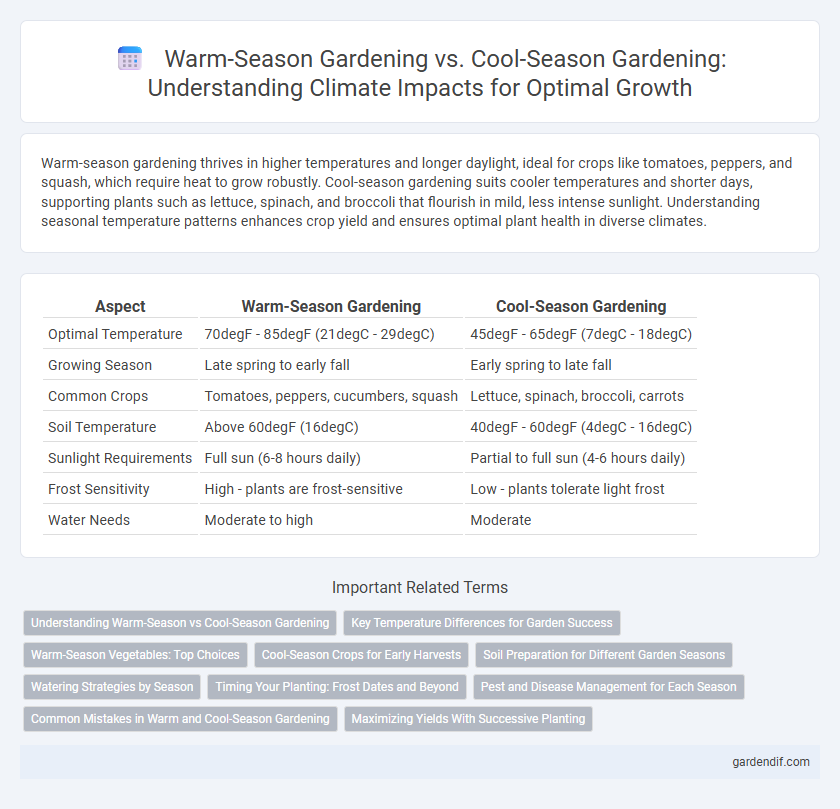
Warm-season gardening vs Cool-season gardening Illustration
Warm-season gardening thrives in higher temperatures and longer daylight, ideal for crops like tomatoes, peppers, and squash, which require heat to grow robustly. Cool-season gardening suits cooler temperatures and shorter days, supporting plants such as lettuce, spinach, and broccoli that flourish in mild, less intense sunlight. Understanding seasonal temperature patterns enhances crop yield and ensures optimal plant health in diverse climates.
Table of Comparison
| Aspect | Warm-Season Gardening | Cool-Season Gardening |
|---|---|---|
| Optimal Temperature | 70degF - 85degF (21degC - 29degC) | 45degF - 65degF (7degC - 18degC) |
| Growing Season | Late spring to early fall | Early spring to late fall |
| Common Crops | Tomatoes, peppers, cucumbers, squash | Lettuce, spinach, broccoli, carrots |
| Soil Temperature | Above 60degF (16degC) | 40degF - 60degF (4degC - 16degC) |
| Sunlight Requirements | Full sun (6-8 hours daily) | Partial to full sun (4-6 hours daily) |
| Frost Sensitivity | High - plants are frost-sensitive | Low - plants tolerate light frost |
| Water Needs | Moderate to high | Moderate |
Understanding Warm-Season vs Cool-Season Gardening
Warm-season gardening thrives in temperatures above 70degF, promoting growth for heat-loving plants like tomatoes, peppers, and beans, while cool-season gardening favors temperatures between 40degF and 70degF, supporting crops such as lettuce, spinach, and broccoli. Soil temperature plays a crucial role, with warm-season plants requiring soil temperatures above 60degF for optimal germination, contrasting with cool-season crops that can tolerate and even prefer cooler soil conditions. Proper understanding of these temperature ranges and plant tolerances ensures successful crop yields and efficient garden planning throughout different seasons.
Key Temperature Differences for Garden Success
Warm-season gardening thrives when temperatures consistently range between 70degF and 85degF, ideal for heat-loving crops like tomatoes, peppers, and squash. Cool-season gardening requires cooler temperatures, typically between 45degF and 65degF, which support crops such as lettuce, spinach, and broccoli that can tolerate light frost. Understanding these key temperature differences ensures optimal plant growth, reduces stress, and maximizes yield in seasonal gardens.
Warm-Season Vegetables: Top Choices
Warm-season vegetables such as tomatoes, peppers, cucumbers, and eggplants thrive in temperatures between 70degF and 85degF, making them ideal for summer gardening. These crops require full sun exposure, well-drained soil, and consistent watering to maximize yield and flavor. Selecting varieties like cherry tomatoes, bell peppers, and zucchini can enhance garden productivity in warm climates, benefiting from longer growing seasons and higher temperatures.
Cool-Season Crops for Early Harvests
Cool-season crops thrive in temperatures between 45degF and 75degF, making them ideal for early spring and fall harvests. Varieties like spinach, kale, broccoli, and radishes are resilient to frost and grow quickly, enabling gardeners to maximize yields before warmer weather arrives. Utilizing cool-season gardening techniques extends the growing season and ensures a steady supply of fresh vegetables during cooler months.
Soil Preparation for Different Garden Seasons
Warm-season gardening requires thoroughly warming and loosening soil to promote rapid root growth, with organic compost enhancing moisture retention and nutrient availability. Cool-season gardening benefits from soil enriched with slow-release fertilizers and light tilling to improve aeration while preserving soil structure for seed germination in cooler temperatures. Proper soil pH adjustment is crucial in both seasons to optimize nutrient uptake and support healthy plant development.
Watering Strategies by Season
Warm-season gardening requires deep, infrequent watering to encourage strong root growth and conserve moisture during hot, dry periods. Cool-season gardening benefits from more frequent, shallow watering to maintain consistent soil moisture and support young, tender plants in cooler temperatures. Adjusting watering schedules based on seasonal evaporation rates and plant water needs optimizes growth and reduces water waste.
Timing Your Planting: Frost Dates and Beyond
Warm-season gardening thrives when planting occurs after the last spring frost date, ensuring soil temperatures consistently exceed 60degF for optimal seed germination and growth. Cool-season gardening benefits from early sowing before the first fall frost, exploiting cooler temperatures for crops like lettuce, spinach, and broccoli that tolerate light frosts and mature quickly. Understanding regional frost date averages and microclimate variations enhances planting schedules, maximizing yield and extending the growing season.
Pest and Disease Management for Each Season
Warm-season gardening often faces challenges from pests like aphids, whiteflies, and spider mites, which thrive in higher temperatures, requiring vigilant pest monitoring and targeted organic treatments. Cool-season gardening tends to deal with fungal diseases such as powdery mildew and downy mildew due to increased moisture and cooler temperatures, emphasizing the need for proper spacing and disease-resistant plant varieties. Integrated pest management strategies tailored to each season's conditions improve plant health and reduce chemical use in both gardening approaches.
Common Mistakes in Warm and Cool-Season Gardening
Planting warm-season crops too early or cool-season crops too late frequently results in stunted growth and poor yields due to temperature stress and disease susceptibility. Overwatering cool-season plants can promote root rot, while underwatering warm-season plants often causes wilting and reduced photosynthesis. Failure to account for soil temperature and moisture requirements common to each season leads to nutrient deficiencies and pest infestations hampering garden productivity.
Maximizing Yields With Successive Planting
Warm-season gardening thrives in temperatures above 70degF, enabling the cultivation of crops such as tomatoes, peppers, and beans with successive planting cycles to maximize yield throughout the growing season. Cool-season gardening, optimal between 45degF and 65degF, supports crops like lettuce, spinach, and broccoli, allowing gardeners to stagger plantings for continuous harvest and efficient space use. Implementing successive planting techniques in both warm and cool seasons ensures prolonged productivity and resource optimization in diverse climate conditions.
Warm-season gardening vs Cool-season gardening Infographic

 gardendif.com
gardendif.com